Improved electrical conductivity of TPU/carbon black composites by addition of COPA and selective localization of carbon black at the interface of sea-island structured polymer blends
Abstract
The electrical percolation threshold of carbon black (CB) in thermoplastic polyurethane (TPU) decreases by 46% with the incorporation of 20 wt% polyamide copolymer (COPA) through selective localization of CB particles at the interface of sea-island structured TPU/COPA blends. Composites with a composition of TPU/20 wt% COPA/9 wt% CB were prepared by four different mixing sequences and their morphologies were investigated by FESEM and TEM. The majority of CB particles were observed at the interface of sea-island structured blends irrespective of the compounding sequence used, although the percentage of CB particles at the interface is considerably less in the composite prepared by adding COPA to premixed TPU/CB. The driving force for the interfacial localization of most CB particles is the hydrogen bonding of CB with both TPU and COPA, which is confirmed by FTIR and DMA investigations. CB particles act like Janus particle-type compatibilizers with bonded TPU molecules toward the TPU phase and bonded COPA chains toward the COPA phase. Highly efficient conductive paths are formed through the CB-covered domains and a short inter-domain distance.



 Please wait while we load your content...
Please wait while we load your content...